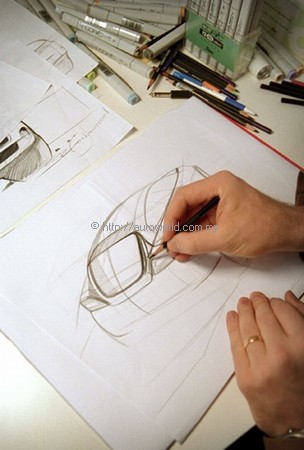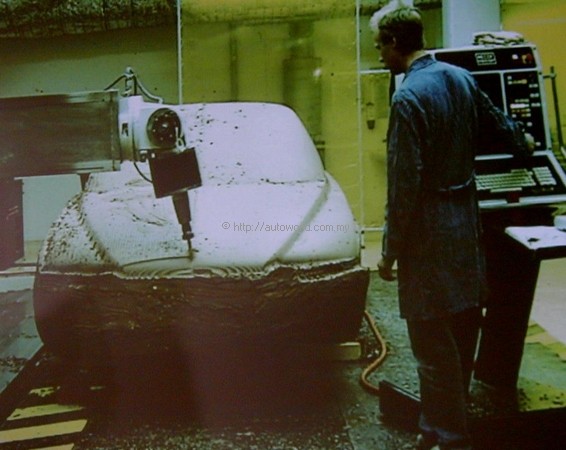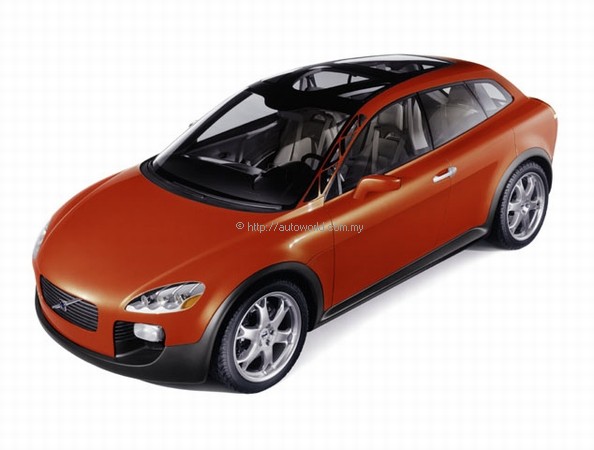Virtual Car Design at Volvo
In the earliest days of the car, designing was done by making some sketches and adding dimensions. It was simple and probably done with just a few sheets of paper. Then as the car grew in complexity, it required more detailed drawings and serious engineering details.
Computers took designing a big leap forward, reducing time and increasing accuracy. Companies wasted no time in getting powerful Cray supercomputers which had enough computing power to carry out simulations which require millions of calculations per second. This enabled engineers to very quickly assess designs for aerodynamic efficiency and more importantly, crash safety.
In fact, as computers grew more powerful, the need to build expensive models declined. Prototyping could be done virtually using powerful CAD tools and the design work taken to a very advanced stage before actual models needed to be built for crash tests. Of course, full-sized models are still needed for evaluations and approval by top management. Seeing designs on-screen do not give the ‘feel’ which is crucial when making a decision to go ahead and build a new model.
As PC users will understand, as computer processing power has grown, the speed of work done on the computer has accelerated. In the early spreadsheets, it would take a while to calculate or recalculate a large sheet of data; today, it can happen in a flash.
Likewise in the world of virtual car design: in 1994, it took several hours to display a design sketch on a computer – now, it takes just 30 seconds! The modern car designer has the fantastic advantage of being able to design a car from concept to finished product in a few weeks using a supercomputer program like Alias, which is what Volvo designers use.
So if one regards the early 1990s as the ‘stone age’ of the design process, then in a space of less than a decade, it has made a gigantic leap forward. However, the designers will still continue to use pencil and paper, as well as the polystyrene model, as essential design tools.
Stefan Jansson, a designer with Volvo, recalls the evolution of the virtual design process in the company, describing it as “explosive”. “In 1994, the Art Centre College of Design in Switzerland – the oldest car design school in the world – had computers but by modern-day standards, they were really antique,” says the 30-year old Swede who is Studio Chief Designer for the exterior design of Volvo’s large platform. “You logged into the computer and opened your big design file. Then you went off to work for a few hours on your physical model. Later, if you wanted to modify a feature of the design – a shading detail perhaps – you could take a coffee break while the program executed it.”
“Now, a mere eight years on, you can display the model in 30 seconds and make the same shading modification in five seconds…” he says.
Jansson emphasises that a physical model is still necessary, explaining that as in all development fields, virtual development naturally reduces the need for physical models and mockups. “I cannot foresee a situation in which we will be able to dispense with them completely. Nor can we escape the fact that we use pencil and paper to develop our initial concepts. Freehand sketches must be made before work on the computer is even started,” he says.
He talks about the importance of a feeling for lines, as well as surfaces and reflections. However well the computer can simulate these things, the human senses must have an input before the design is finalised.
“The virtual image must be verified physically and a model of the car must be produced, preferably in full scale,” he notes.
“The SCC concept car is an extreme example of how we can work. This was a rapidly executed project which was to culminate in the production of a single example of the car. Once the computer design was finalised, we built two models – one a full-scale reproduction of the special ‘see-through’ A-post and the other a 1:10 scale model of the complete car. These were produced by an SLA (stereolithography) machine, in which liquid plastic is hardened by ultraviolet light in a tank.”
“Two weeks before the dies were to be made, we milled a full-scale model of one half of the car from polystyrene, providing a smooth, fine-surfaced model which was easy to study. This produced a list of about twenty minor modifications which were made by computer within a week. We then did the same thing with the other half and carried out another five small changes. After that, the car was ready to be built. The differences between the actual car and the computer version were insignificant,” he reveals.
He goes on to explain that modern programs enable geometrical information to be used during the entire period that the car is being ‘built’ in the computer. As an example, the designer may opt to include either the complete engine or only its ‘corners’ to reduce the size of the document. The number of variations is almost limitless.
Known as Alias, the design program was developed both for design applications and the film and computer games industry. The films Titanic and Jurassic Park are notable examples of its use.
“In films and computer games, the main requirements are rapid action and mobility,” says Jansson. “Our quality requirements are greater since they relate to surfaces which must be produced. And although everything in the virtual design is nice and refined, we still need to use pencil and paper first – in the end, that’s also a form of virtual design…”
He describes the process, starting with the first sketches of the concept on paper, perhaps in the form of a side view, which is then scanned into the computer. “Lines are drawn and we start to work in 3D,” he continues. “We integrate the lines and once a number of curves are developed, we can derive a surface from them. This we can modify by pulling, drawing, stretching, and so on. Adjustments are needed all the time and changes are made in 3D.”
“Surface after surface is built up in this way, and the transitions from one to another must work. The surfaces are simple and angular in the early stages, but gradually become gentler and more complete. The time taken to develop the basis for a physical model may be as short as 1-2 weeks,” he adds.
Despite the sophistication of the models, they are not too big for easy transmission to the design engineers or to suppliers. An exterior model may be as small as 20MB and a complete interior no more than 100MB. Having studied the proposal, the designers respond with feedback.
“They use the same design models as us, but only as information. They are not permitted to modify the design model themselves, but we do need their feedback to produce a design that can be built. In years gone by, clay models were produced from the design sketches. These were measured physically and modification was a highly complicated affair. Today, the models are scanned by laser, which returns information directly to the computer – precise information which makes modification easy,” says Jansson.
Although he regards virtual design as a fantastic tool, he sees risks in it: “The process is fast and efficient – but it can be too fast. There can be a temptation to make decisions too early – forfeiting the opportunity of going back to make important changes. A design must be allowed to mature, to give time for reflection. The SCC, for example, did not have time to mature properly – we shot from the hip. Nevertheless, it did receive complete approval and I’m still happy with it,” he reveals..
“Virtual design enables you to keep better track of where you are in the process. It also leads more quickly to the stage at which models can be built and necessitates fewer modifications later on. You can aim at the target from Day 1 and obtain the right information for decisions earlier on. This saves money since clay models are expensive, although there may be some lines which are easier to visualise in clay than on the computer. A clay model is still required for verification,” believes Jansson.
“The end result must be a production car of the highest quality, which will be appreciated by large numbers of buyers,” he emphasises.
The same Alias models, which are also used by the design engineers, can be tested in virtual wind tunnels, yielding very accurate drag coefficients and enable dirtying, cooling characteristics and other factors to be evaluated early in the development process. “Driving in desert heat or arctic cold can also be simulated, with excellent results,” adds Jansson.
“A design process in which the computer can do everything is feasible. As a human being, however, you need something tangible to evaluate,” he believes. “This applies especially to the interior of the car – for which a test series must be produced. Everything inside the car must be evaluated with all five senses, not just visually. A surface is something you have to feel!”
He adds that it is occasionally pleasant to take time to explore one’s ideas, even if they are unrealistic. It costs nothing to try out various things on the computer. In the early stages, when there are no physical models, the designer can work on perhaps a dozen computer designs before reducing them to just one.
Though a powerful program, Alias can be run on a laptop. This allows the designers to travel anywhere in the world to gather ideas and impressions – which is necessary to sell the car in a given market. Or to obtain that vital inspiration which is needed to add the finishing touches to its design.





























